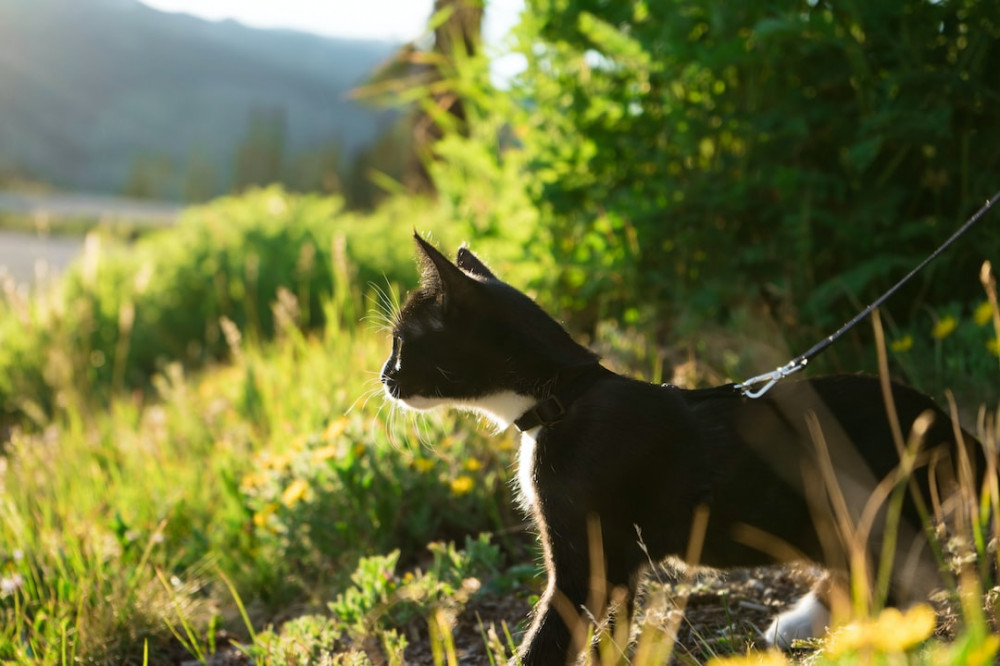
Hello, Cat Enthusiasts!
Today we are going to learn how to train a cat to walk on a leash.
Get the Right Equipment
Before you start training, it’s important to get secure, convenient and comfortable equipment.
How to use a cat collar and harness? Cat collars can be used for attaching identification tags or bells. On the other hand, harnesses are specifically designed for supervised outdoor activities. When you need to have your cat on a leash, always use a cat harness. Never walk your cat with a leash attached to the collar as cats can easily slip out of it or get injured.
Choose a properly fitting harness. The right harness must be comfortable but at the same time tight enough to prevent your cat from escaping. Measure your cat’s neck and chest (girth) using a measuring tape and choose a size of harness based on those measurements.
Prepare Your Cat for Walking
Now that you have the proper gear, you can begin training. It’s best to start out by training your cat to feel comfortable wearing a harness. Cats don’t like foreign objects on their fur, so wearing a harness (not to mention getting outside) for the first time can be a very stressful experience for a cat. Here are some recommendations that will help familiarize your cat with the harness.
1. When you bring new harness home, allow your cat to get used to its sight and smell. Put the harness down and let the cat check it out. Reward the cat with treats and affection for investigating the harness to help your cat create a positive association with this object. Leave the harness for your cat like this for short periods of time several times a day until the cat get accustomed to new object. However, avoid sending mixed messages – don’t leave the harness among your cat’s toys and don’t use it as a toy.
2. Next step – put the harness on (but don’t tighten the belts) and reward the cat. After a few minutes, remove the harness. If the cat tries to remove it immediately, distract it with toys or treats and remove the harness only when the cat calms down. Repeat this several times a day until your cat calmly tolerates the harness. Then you can start making each session longer.
3. If your cat is comfortable with the process, you can gradually tighten the harness until it is properly adjusted (when you’re able to fit a finger between the harness and the cat’s body).
4. You can also play with the cat during sessions with the harness or put the harness on at mealtime to develop positive associations.
5. Be patient and practice every day. Keep sessions short (10-15 minutes) and supervise your cat at all times when it wears the harness.
Walk Indoors
Once your cat is accustomed to the harness, it’s time to add the leash. Attach the leash to the harness and let your cat drag it around. At the same time, give your cat treats and praise it. Keep your sessions short at the beginning and increase the time gradually. Repeat this for several days.
Then you can pick up the leash and follow your cat around the house. Keep your walks to 10-15 minutes and reward the cat all the time.
Walk Outdoors
Now that your cat is comfortable wearing a harness and leash and walking with you indoors, you can begin walking outside. At first, leave the door open and allow your cat explore new territories at its own pace. If the cat seems frightened or doesn’t want to go outside, don’t force it, just try again another day. You can also carry your cat to a peaceful place for a few minutes early in the morning.
Keep it positive and always reward the cat for staying calm. If your cat enjoys walking, take it out regularly and gradually increase the time with each new walk.
At the beginning, it’s good to take with you a carrier and a towel in case your cat panics, especially if you can’t return home quickly. Use the towel to place the cat in a carrier as frightened cats often act aggressively.
You should always be behind your cat. This will prevent the cat from slipping out of a harness and give it control over the walking route.
Keep in mind that some cats can be trained to wear a harness and leash but refuse to walk outdoors. If your cat gets stressed every time you take it outside, it’s better to stop trying to go for a walk. Always remember that training and walks should be enjoyable and comfortable for both you and your cat.
Extra Safety Tips
#1. Do harness and leash training indoors. Don’t venture outside if your cat isn’t accustomed to the harness.
#2. Never take your cat outdoors without the harness and leash. Always hold the leash and never give your cat complete freedom while outside even for a few moments.
#3. Don’t leave the cat in a harness unattended, whether indoors or outdoors.
#4. Your cat must be treated against parasites and have all vaccinations.
#5. Wait for good weather to go outside. The temperature should be comfortable for the cat. If it’s raining, cold or hot, it’s better to stay home.
#6. Choose quiet places for walks, avoid open spaces, public parks, roads and places where dogs are walked. It’s better to stay close to home in case you need to return quickly.
#7. Put the collar with ID tag on your cat in case of escape.
#8. Don’t use a retractable leash. Your cat can encounter potential prey and predators just about any time and dart away.
#9. Do your homework and be watchful when you’re out with your cat to avoid potentially dangerous situations. Think through possible bad scenarios before you take your cat for a walk and be prepared to act quickly.
#10. Watch your cat’s body language and end the walk if you notice signs of anxiety or fear.
#11. Always take with you a first aid kit and water for the cat.
#12. Walks can increase your cat’s desire to go outside on its own. When using the door, be careful that your cat doesn’t run away.
Final Thoughts
Most cats can be trained to wear harness, especially if you make this process fun and rewarding for the cat. However, not every cat really needs to go outside. Before taking your cat for the first walk, thoroughly assess risks and benefits of outdoor exposure and discuss it with your veterinarian to make the right choice for your cat.
If you have something to add or wish to share your experience, please leave a comment.
Thank You For Reading!
